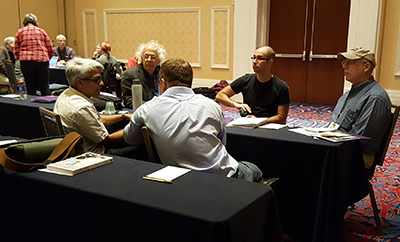
Each of the three working groups addressed one of the following topics:
- Accessibility in ECS
- Accessibility in CSP
- Training K-12 Teachers
Their discussions are summarized below.
Accessibility in ECS
Suggestions for addressing accessibility in ECS includes the following:
- In ECS professional development materials, Quorum is mentioned at the very beginning when a video is shown about students with disabilities. It should be mentioned again when programming is covered. A video that specifically addresses Quorum could be useful.
- The ECS curriculum seems strict on the surface, yet many teachers find room for additions and changes. If Scratch is not accessible to some students, teachers needs to be presented with an alternative accessible option that could be used with the same ECS curriculum.
- AccessCSforAll should increase its efforts with the K-12 education community to get more people involved in accessibility.
- Representatives from AccessCSforAll could attend more professional development sessions and teach about accessibility and diversity.
- Since a main focus of ECS curriculum is equity and inclusion, having a variety of underrepresented groups discussed (rather than only racial/ethnic diversity) should be addressed in the curriculum.
- Educators who work with students with disabilities should be encouraged to participate in the Hour of Code so they become more comfortable with programming. This involvement may make them more likely to recommend computing courses to their students.
Accessibility in CSP
This group discussion included the following:
- Data visualization is a stumbling block for many teachers. We need a way to make data visualization tasks accessible, more resources for teaching data analysis, and age appropriate data sets to use.
- One resource used in some CSP courses is the online book Expeditions through Alice by Beth Simon. Having a Quorum version of this book could be helpful.
- Checklists should be modified to fit specific situations, workspaces, and people—putting dates on these checklists as to when a user wants to complete a task by.
- Resources that might be useful for teachers include Cameo (tactile electronic cutter), adhesive.com (MOOC), abstractingCS.com (resources developed by CSP developers), snapguide.com (physical toys), GapMinder.org (statistics resources), Baby Name Wizard (data source site).
Training K-12 Teachers
Suggestions brought out by this group include the following:
- Teachers of CSP need to be aware about how accommodations work for performance tasks. According to the Educational Testing Service (ETS), accommodations for performance tasks should be determined and implemented locally.
- Educators need to give students the tools and skills to advocate for themselves. This will prepare them for computing courses, but also for life beyond high school.
- Trainers should consider including special education teachers in computer science professional development, so they won’t be intimidated with teaching computer science or recommending it for their students.
- Teachers would benefit from a just-in-time support guide that details specific accommodations that could be implemented for each lesson in the curriculum for students with specific disabilities.